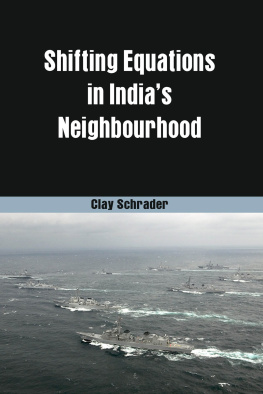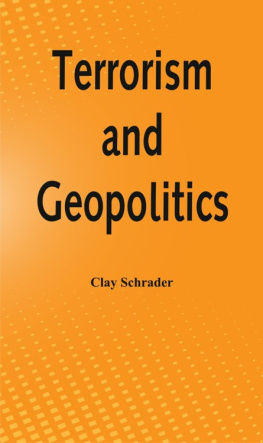Shifting Equations in Indias
Neighbourhood
Shifting Equations in Indias
Neighbourhood
Clay Schrader
Alpha Editions
Copyright 2018
ISBN : 9789352978595
Design and Setting By
Alpha Editions
(A Vij Publishing Group Company)
www.vijbooks.com
email
All rights reserved. No part of this publication may be reproduced,
distributed, or transmitted in any form or by means, including
photocopying, recording, or other electronic or mechanical methods,
without the prior written permission of the publisher.
The views and characters expressed in the book are of the author
and his/her imagination and do not represent the views of the
Publisher.
Prime Minister Modi could not have been more different in style and projection from the diffident Singh. In assessing Modis foreign policy it is important to appreciate that the pace of change in global affairs has picked up speed. Past ideological rivalries have been substituted by challenges to democracies like India and the US from one-party states, such as China; so-called illiberal democracies, such as Russia; and the rise of right wing parties in Europe.
The developments affecting Indias neighbourhood over the past decade have led India to take a close look at her foreign and security policies. There is a widely shared belief that India has to formulate policy options to secure her national interests, keeping in view the changes occurring in her neighbourhood.
In this book is Bhutan made the transition from monarchy to constitutional democracy, Bangladesh, Pakistan, and Myanmar moved from praetorian to civilian regimes. Monarchy came to an end in Nepal and Maldives became a presidential republic even as Afghanistan, India, and Sri Lanka witnessed their democracies at crossroads.
Military Strength of India and Pakistan which is a good way to compare both Countrys Army, Naval and Air Force Strength. All the matter is just compiled and edited in nature. Taken from the various sources which are in public domain.
Indias relations with its neighbours will depend upon developments in individual countries but also the broader trends which shape the region as a whole. Several critical drivers that may influence the South Asian situation can be identified. These drivers are uncertain but can have huge impact. They include demography, internal stability, economic growth, energy security, climate change, food and water security, terrorism, antiIndia sentiments and external powers.
The political, economic and social landscape in Indias immediate neighbourhood has changed significantly since the end of the Cold War. A power transition is under way in the global order. The bipolar world has given way to a non-polar world in which several new powers have emerged. The centre of gravity of power is shifting towards the AsiaPacific. The simultaneous rise of India and China is a development of great significance.
The India-Russia connection is the only bilateral relationship that is referred to as friendship. For more than five decades, people from both countries have had warm feelings towards each other, and although the fervour of the 1970s and 1980s has faded somewhat, there still remains the recognition of each other as reliable partners. It is for this reason that Prime Minister Narendra Modi said in December 2014, during Russian President Vladimir Putins visit to India: Even a child in India, if asked to say who is Indias best friend, will reply it is Russia because Russia has been with India in times of crisis.
This is a reference book. All the matter is just compiled and edited in nature, taken from the various sources which are in public domain.
It is hoped that the book will be able to provide rich material for serious students of Indian foreign policy planners administrators and politicians alike.
Editor
The foreign policy of Narendra Modi (also referred to as the Modi Doctrine) concerns the policy initiatives made towards other states by the current Modi government after he assumed office as Prime Minister of India on 26 May 2014. The Ministry of External Affairs, headed by External Affairs Minister Sushma Swaraj (the first woman to hold the office since Indira Gandhi), is responsible for carrying out the foreign policy of India. Modis foreign policy is currently focused on improving relations with neighbouring countries in South Asia, engaging the extended neighbourhood in Southeast Asia and the major global powers. In pursuit of this, he has made official visits to Bhutan, Nepal and Japan within the first 100 days of his government, followed by the United States, Myanmar, Australia, and Fiji. Swaraj has also made official visits to Bangladesh, Bhutan, Nepal, Myanmar, Singapore, Vietnam, Manama, Bahrain, Afghanistan, Tajikistan, United States, United Kingdom, Mauritias, Maldives, United Arab Emirates, South Korea, China, Oman and Sri Lanka.
BACKGROUND
While Chief Minister of Gujarat, and under sanction from Western states like the United States, Modi made several foreign trips to foster his business links with major Asian economic powers. This included meeting Japanese Prime Minister, Shinzo Abe twice in 2007 and 2012 and building a personal rapport. He also reached out for investment deals with China and Israel, who sought to increase economic ties beyond defence and agriculture, according to outgoing Israeli Ambassador Alon Ushpiz. He was widely appreciated for his endeavour to organise Vibrant Gujarat, a biannual international business summit, to welcome investment in his home state which also helped build a pro-development and business friendly image.
INDIAS FOREIGN POLICY CHALLENGES IN 2014
China
Since the new millennium, relations between India and China have been characterised by hot economics and cold politics or cooptetioneconomic cooperation and political competition. In recent years, tensions between the two countries have increased due to the border dispute. According to Dr Harsh Pant at Kings College London, the lingering border dispute between India and China continues to be the single-most important impediment, though increasingly the larger context of this relationship is undergoing a transformation. As the balance of power in Asia changes and India strives to manage the rise of China with its own blend of internal and external balancing, this will assume a bigger profile in Sino-Indian bilateral ties. It is highly unlikely that relations between the two rising giants will improve in 2014, and will continue to be characterised by cooptetion and military confrontation in the medium term.
Pakistan
The enduring Indo-Pakistan rivalry is well known. The Kashmir conflict and cross-border terrorism have historically led to tensions between the two countries. The beheading of an Indian soldier along the Line of Control (LoC) in January this year and incessant ceasefire violations since have vitiated relations between the two countries. LSE Professor Sumantra Bose avers that cross-border incidents as well as terrorist incidents are symptoms of the deeply conflictual nature of the India-Pakistan relationship. The Kashmir dispute is real and important, but has simply provided a focal point for a multifaceted and deeply rooted antagonism. The emphasis on security obscures other aspects of the relationship, including a growing appetite on both sides of the border for increased bilateral trade. In the context of increasingly adverse domestic political environments in both countries the jingoistic right-wing in India and Pakistans irredentist military hindering the diplomatic process, there is an even greater need to re-think India- Pakistan relations in 2014.











